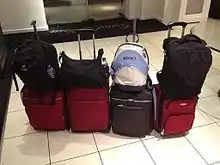Nosework
Nosework is a dog sport sport created to mimic professional detection dog tasks. One dog and one handler form a team. The dogs must find a hidden target odor, often ignoring distractors (such as food or toys), and alert the handler. After the dog finds the odor they are rewarded with food or a toy.

Odors
Dogs hunt for specific odors. Unlike working with professional detection dogs, all odors used in sport nosework are legal to carry and own. Each governing body sets their own standard for which odors are the target odors and which levels they are paired with. At the lower levels, a single odor would be used. At higher levels, two or three of the odors might mixed to create a unique combination odor.[1] The odor is often dripped on a cotton swab, which is then hidden in a search area. The odor-dipped swap is called the 'hide'. The odors used include: Anise, Birch, Clove, Myrrh, Pine, Thyme, Vetiver oil, and Wintergreen.
Elements

An element is a specific type of search area used in nosework.
Interior building search takes place on the inside of any building. Searches can be a single one room or multiple rooms. There is often an option for the search to be done on or off-leash.
Exterior area search takes place outside, often it contains grass, dirt, cement and/or gravel. These searches can be especially difficult for the dogs as there are a number of new smells (trash, food, animals, etc.), the dogs work in all weather conditions, and the dogs may be tempted to mark or eliminate.
Vehicle searches are usually three or more vehicles. The 'hide' is always on the outside of the vehicle. The types of vehicle used varies from compact cars to horse trailers to semi-trucks.
In container searches, the types of containers used varies depending on the level. Beginning levels use plain white cardboard boxes. More advanced levels use luggage, plastic bins, etc. Containers may be arranged in a pattern or randomly on the floor, or they may be placed up on chairs in a higher level.
Governing bodies
- National Association of Canine Scent Work (NACSW): is the oldest governing body in nosework, established in the mid-2000s.[2]
- United Kennel Club (UKC) Nosework: UKC was the second organization to become a sanctioning body for nosework trials. Official trials are set to begin after January 1, 2015.[3]
- Sport Detection Dog Association (SDDA): The SDDA is the first Canadian sanctioning body for nosework. Established in 2013, their first trial in western Canada took place in October 2014.[4]
Levels
The National Association of Canine Scent Work has three title levels. the first level (NW1) shows proficiency in one odor, four elements, with one 'hide' in each element. Level NW2 has two odors, four elements, two hides per element, and the container search will contain at least one distractor (food, toys etc.). Level MW3 has three odors, multiple hides in each element, and the interior search may even have no hides at all and must be called "Clear" by the team.[1]
The Sport Detection Dog Association uses only three elements; they don't use vehicle. With SDDA, level SD-S has one odor, three elements, and one hide per element. Level SD-A has two odors, three elements, up to two hides for each element, and one distractor for container. Level SD-E has three odors, three elements, up to three hides for each element, and one distractor for container.[6]
The United Kennel Club uses five odors and has five levels/titles including: Novice Nosework, Advance Nosework, Superior Nosework, Master Nosework, and Elite Nosework.[7]
The Australian Canine Scent Work follows the rules and format of NACSW.[8]
Benefits for behavioral problems in dogs
Nosework is a relatively new sport so little research has been done on it as a behavior modification tool.
A paper was presented at the 2011 American College of Veterinary Behaviorists and American Veterinary Society of Animal Behavior symposium, by Dr. Valli Parthasarathy on using nosework as a behavior modification protocol.[9] One pilot study has been done to see if human perceptions of canines change after a nosework class.[10]
Some anecdotal evidence suggests nosework has helped dogs with behavior problems. Canines with a fear of humans can work and be rewarded in an environment with people around, but the dogs are not forced to interact. In nosework dogs are worked one at a time, so canines with dog aggression are able to have fun without other dogs in close proximity.[11]
There can also be an increase in time spent with the dog, while participating in nosework. Research has shown that even a slight increase in time spent interacting with your dog, will decrease the dog's separation anxiety, improve obedience and help form a stronger human-canine bond.[12]
References
- "Trial Rule Book | NACSW". nacsw.net.
- "About Us | NACSW". nacsw.net.
- "Nosework". United Kennel Club.
- "Sporting detection dogs Association – Providing registration, education and titling in Sporting Detection".
- "ACSW | ACSW".
- "Rulebook – Sporting detection dogs Association".
- "Nosework Forms and Rules | United Kennel Club (UKC)". www.ukcdogs.com.
- "Rulebook | ACSW".
- Parthasarathy, V (July 15, 2011). "What Smells? Using Scentwork as Part of Behavior Modification Protocols" (PDF). p. 48. Archived from the original (PDF) on January 9, 2015.
- Association of Pet Dog Trainers Foundation. "Research Poster Presentations 2014".
- http://www.campwaggingtails.com/wp-content/uploads/Nose-Work-Article-from-Vet-Behavior-Newsletter.pdf
- Clark, G. and Boyer, W. (1993). The effects of dog obedience training and behavioural counselling upon the human-canine relationship. Applied Animal Behaviour Science, 37(2), pp.147-159.
